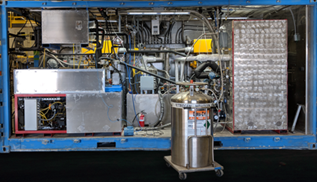Above: Cryogenic Carbon Capture™ is one example of a technology developed with NETL oversight and support that’s been acquired by industry for commercial deployment.
Several innovative technologies developed with support, expertise and strategic guidance provided by NETL have been licensed for use in next-generation commercial applications to capture carbon dioxide (CO2) from power and industrial plants to lower atmospheric emissions of greenhouse gas.
“The licensing of these technologies is the result of decades’ worth of research and development to find science-based, cost-effective solutions to address climate change while sustaining the economic prosperity and equity of our domestic power and industrial sectors,” said José Figueroa, supervisor, NETL Carbon Capture Team.
The NETL Carbon Capture Program portfolio is advancing a range of technology solutions aimed at step-change improvement in the economics, efficiency and reliability of carbon capture to address the climate crisis and meet the carbon management goals of the Biden Administration, which call for net-zero carbon emissions in the power sector by 2035 and the broader economy by 2050.
“At NETL, our expertise and support enable researchers in industry and academia to undertake challenging issues related to carbon management. With NETL oversight and guidance, projects can advance from the conceptual stage to pilot studies and eventually to the point where they are ready for licensing and commercial application,” said NETL’s Krista Hill, a federal project manager.
“It is a rewarding experience to see these technologies advance to the point where they can have real-world impact,” she said.
Hill and Figueroa point to Cryogenic Carbon Capture™ (CCC) as one example of a technology developed with NETL oversight and financial assistance that’s been acquired by Chart Industries for commercial deployment.
The CCC process cools down a waste stream, such as flue gas from a fossil energy plant, containing CO2. When the waste stream is cold enough, the CO2 desublimates into dry ice, which is then separated from the light gases. The cold products are utilized in recuperative heat exchangers to assist in cooling the incoming waste stream.
During the recuperative step, the dry ice melts, forming liquid CO2. The liquid CO2 can then be pumped up to pipeline pressures for transport and permanent sequestration in subsurface storage sites. The technology offers a bolt-on solution for existing systems and provides the ancillary benefit of removing criteria pollutants.
Work continues to develop the CCC technology for applications such as cement production, which is a significant industrial source for CO2 emissions. In October 2021, the U.S. Department of Energy (DOE) announced nearly $5 million in funding to design, build, commission and operate an engineering-scale CCC process at the Eagle Materials/Central Plains Cement Sugar Creek Plant in Sugar Creek, Missouri. Sustainable Energy Solutions, the industry partner in the development of the CCC technology, and other partners are providing $10.5 million in cost-shared funding, which is approximately two-thirds of the total project value. The project will be managed by NETL.
An advanced solvent to capture CO2 from point sources at fossil-fueled power plants, as well as from steel and cement manufacturing sites, is another recent example of a technology developed with NETL project governance that has been licensed for commercial deployment.
In December, Honeywell and the Texas Carbon Management Program at the University of Texas at Austin announced a licensing agreement to leverage the technology in which CO2 is absorbed into an amine solvent and then sent to a stripper where CO2 is separated from the solvent. The CO2 is then compressed for geological sequestration or used for other purposes.
“The advanced solvent is an organic compound that reacts faster than other compounds to CO2 and is stable at higher temperatures, allowing it to operate at higher pressures. The technology can be retrofitted within existing facilities or included as part of a new installation,” Hill said.
Also in December, Baker Hughes announced it has entered into a global exclusive licensing agreement with SRI International to use SRI’s innovative mixed-salt process (MSP) for CO2 capture. Hill said NETL support of this technology development led to SRI licensing the technology to Baker Hughes. The SRI MSP will soon be tested at engineering scale at the University of Illinois Abbott Power Plant in a 0.5-megawatt electric (MWe) equivalent pilot campaign.
MSP is a post-combustion, carbon capture process that uses a solvent formulation based on readily available potassium and ammonium salts. It has achieved a technology readiness level of 4 (technology validated in lab). SRI’s process offers reduced energy consumption and is suitable for treating flue gas from power plants and industrial flue gas streams with varying CO2 concentrations.
NETL is a U.S. Department of Energy national laboratory that drives innovation and delivers technological solutions for an environmentally sustainable and prosperous energy future. By leveraging its world-class talent and research facilities, NETL is ensuring affordable, abundant and reliable energy that drives a robust economy and national security, while developing technologies to manage carbon across the full life cycle, enabling environmental sustainability for all Americans.




